 Royal Navy, AA frigates: 15 ships Service 1955-1988+
Royal Navy, AA frigates: 15 ships Service 1955-1988+RN: Blackwood, Duncan, Dundas, Exmouth, Grafton, Hardy, Keppel, Malcolm, Murray, Palliser, Pellew, Russell.
RIN: Khukri, Kirpan, Kuthar
Cold War British Frigates
Rapid class | Tenacious class | Whitby class | Blackwood class | Leopard class | Salisbury class | Tribal class | Rothesay class | Leander class | BB Leander class | HMS Mermaid | Amazon class | Broadsword class | Boxer class | Cornwall class | Duke classThe Type 14 Blackwood class were a more austere variant of the Type 12 purpose-built ASW Frigates of the Royal Navy, a minimal “second-rate” anti-submarine type built in 1950s to complement the conversions while not overtaxing a restricted budget. While addressing the increasing threat of the Soviet Union’s submarine fleet. They were active until the late 1970s with good sonars but the ASW weapons of their day. Twelve were in service with the Royal Navy until 1985 so practically until the end of the cold war, but the further three built for the Indian Navy remained active a bit longer until 1988.
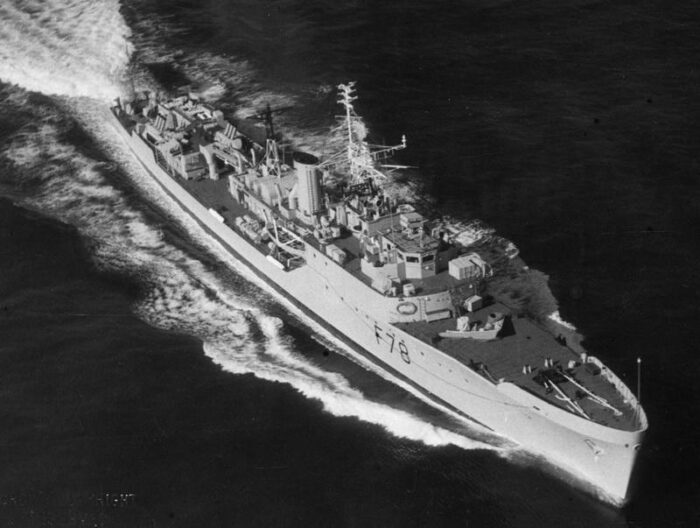
Design Development of the Blackwood class Frigates
The Type 14 frigates were designed in the same spirit that made the conversion of the Type 16 (Tenacious class) Frigates a reality for a budget-stricken postwar Britain. The order of the day was still to fight an expected swarm of mass-produced, crude but still deadly Soviet Project 613 submarines (using German Type XXI tech) codenamed “Whiskey”. No doubt the use of the latter (or Rhum in the RN) was sometimes an answer to the problem… The initial frigates conversions of the Type 15 (Rapid class Frigates) were part of the solution, and the newly-built Whitby class, after the cancellation of the Type 11, the Type 12 Whitby class was a satisfying complement, but for budgetary reasons, both were unsustenable. The Type 16 (Tenacious class) was a far more auster conversion making the best of WW2 destroyers hull now surplus to requirement and obsolete, but the need for new hulls urged an alternative to the Type 12, and thus led to the design of the Type 14 we are seeing there:
A cheaper alternative
The high unit cost of the Whitby class design – 3.5 million pounds – led the Admiralty to consider cheaper vessels which could also be built more quickly: the result was the Type 14 (there was no Type 13), with the same ASW capacity as the Type 12, but with only half the power and virtually every other capability eliminated. All were ordered in March 1951. The result illustrates vividly the problems of building a 2nd rate frigate, for although the Blackwoods achieved exactly what the Staff Requirement demanded qualities at half the cost of the Whitbys – they were not popular in the Navy. Described as a utility design (as against the ‘quality’ Type 12) they were mocked as ‘futility frigates’, for their single-mission design made them inflexible for peacetime use.
What was ignored was the fact that if hostilities had broken out with the Soviet Union in the late 1950s (as many Western defence planners envisaged) there would have been an extra half dozen Type 14s and ten Type 16s. In ASW exercises the Blackwoods often proved superior to more sophisticated frigates, mainly because their inflexibility permitted them to be left to continue their ASW training to a high level, whereas other fregates frequently had their training programmes interrupted. With only half the machinery of the Whitby class the designers had to go for finer lines and less weight to reach 25kts, and so the short forecastle reappeared.
So in short, cheaper and smaller than the expensive Type 12 frigates, lacking gun armament, anti-submarine armament reduced to two Limbo mortars, Mk 20 torpedoes and sonar. This was seemingly an advantage as the crews could entirely devoting to practising anti-submarine warfare and initially they were seen as the most effective frigates in such exercises until the mid 1960s. But when the USSR started series of 30-knots capable SSNs, they were now of little use, and perform fishery protection duties during the confrontations with Iceland…
During their time on patrols around Iceland it was found theit hulls in icy, heavy waters, were too weak. They had to be strengthened to cope with these patrols. Albeit they remained good sea boats throughout the dispute ongoing until the mid-1970s. The low profile of the superstructure was a deliberate design feature but in their new role the lack of a gun and general lack of space were deverly criticized. Experience with these led to the realization that quality was to be the new top priority of all ships, and choice was made of quality over quantity. This seems the right choice as the Soviet Navy also choose that path with its next submarines.
Construction
15 ships were built in all, including the initial 12 for the Royal Navy, enough for two flotillas. They were built at the following yards:
Thornycroft, Woolston: Blackwood, Duncan
White, Cowes: Dundas, Exmouth, Grafton
Yarrow, Scotstoun: Hardy, Keppel, Malcolm
Stephen, Glasgow: Murray, Palliser
Swan Hunter, Wallsend: Pellew, Russell
Naming:
They were all named after British captains that for most took part in the Battle of Trafalgar, and the remained to the Napoleonic wars. Pellew was featured in the excellent “Hornblower” books and TV serie.
Blackwood – Henry Blackwood
Duncan – Adam Duncan
Dundas – James Whitley Deans Dundas
Exmouth – Edward Pellew, 1st Viscount Exmouth
Grafton – Henry FitzRoy, 1st Duke of Grafton
Hardy – Thomas Hardy
Keppel – Augustus Keppel
Malcolm – Pulteney Malcolm
Murray – George Murray
Palliser – Hugh Palliser
Pellew – Israel Pellew
Russell – Thomas McNamara Russell
Modifications of the Blackwood class
All the ships versed to the Iceland patrols saw their hulls strengthened after experiencing exceptionally heavy weather. After this, they proved very seaworthy, giving good service in the Fishery Protection Squadron albeit the lack of gun remained an issue. Blackwood, Exmouth, Malcolm and Palliser were completed with two twin 21-in TT amidships supplementing their Mk 10 mortars, but the tubes were subsequently removed. After a few years in service the after 40mm gun was removed as well, mainly because it could not be used in heavy weather.
In 1966-68 Exmouth was engined with a Rolls-Royce Olympus gas turbine developing 23,200shp, backed up by two Proteus gas turbines for cruising (8500shp) geared to the same shaft. The ship was then put through an exhaustive series of tests, culminating in the adoption of the Olympus/Tyne combination as the future standard propulsion unit for the Royal Navy. There was no dramatic improvement in speed (maximum speed rose to 28kts, cruising speed of 22kts) because the hull could not absorb any great increase in power. The external configuration was unchanged apart from a new streamlined funnel, and fuel was slightly increased to compensate for higher consumption.
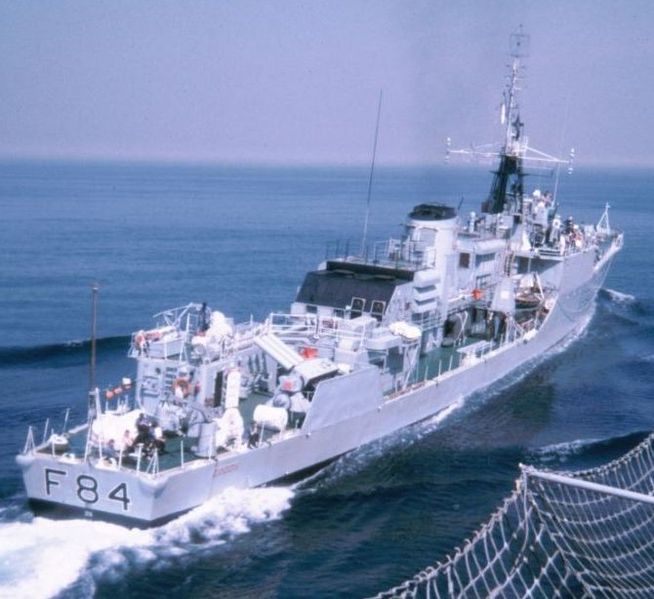
HMS Exmouth as modified in 1972
Exmouth was a valuable for her experimental trials as gas turbine propulsion pioneer and become invaluable for the Royal Navy’s future large ships designs. She became easily distinguishable from her sisters in class due to her larger and non-cylindrical, streamlined funnel with large air intakes located immediately fore and aft of the funnel. This was a complete success leading to the large adoption of all-gas turbine propulsion as standard, applied to the Type 21 & 22 Frigates, Type 42 destroyers, and even the Invincible class carriers.
The Type 14 had a limited size, at just 310 feet (94 m), and so very limited upgrade potential, which restricted their use past the 1970s as no modifications or upgrades could be realistically implemented, notably due to to stability issue: Adding top weight meant pouring concrete in their bottom, making them sluggish whereas they already limited to 27 knots at best on a larke-like sea, down to 18-20 kts or less in heavy weather. No more effective weapons, better suited to the new generation of Soviets sub could be planned, and this made them quickly obsolete. After the Iceland “cod war” abated, they were promptly decommissioned. The last operational was the experimentally modified Exmouth in 1977. Hardy was the other exception, retained for training and attending the Silver Jubilee of Elizabeth II in 1977 as a tribute to those now discarded, as well as deployed a last time on the standby squadron in 1978.
Construction of the Type 14:
Design of the class
Hull and general design


Two drawings are worth a thousand words. The new Type 14 were indeed very different than the Type 12 Frigates. Instead of their low-profile, greyhound-like appearance, mean and graceful, the Type 14 looked far more utilitarian and less refined. They were more compact, making them looking stubbier, which was further exacerbated by their forward raised prow bulwark. Instead of a gradual stepped aft section, they had a classic forecastle and long aft deck. Single funnel also, and short lattice mast, but the absence of any gun forward made them hardly looking like warships. The two Limbo were located aft, and they had of course a pair of staggered Limbo aft, their only “justification” and argument as warships.
They were smaller than the previous Type 12, with an overall lenght of just 310 ft (94.5 m), a beam of 33 ft (10.1 m) and draught 15 ft (4.6 m), and a displacement of 1,456 long tons standard and 1,479 t full load instead of 2150/2560 tonnes for the Whiby, which reached 112.7 meters long and 12.5 meters wide. The Blackwoods were indeed “2nd class” ASW Frigates in all but name.
Powerplant
Another massive difference with the Whitby class was the smaller hull enabled the engineers to get away with a single turbin set instead of two while keeping a relatively “safe” top speed of 27 knots, versus 30+ on the Whitby thanks to a single propeller with a shaft geared steam turbine fed by two Babcock & Wilcox boilers for a total rating of 15,000 shp. Thanks to c300t fuel oil (estimation), their range was still of 4,500 nautical miles or 8334 km or 6,000 miles at 12 knots (22 km/h; 14 mph). If the B&W boilers were standards, depending of the yards, ships had diverging steam tubines:
F78, 80 had Thornycroft geared steam turbines, F48, 51, 84 had White geared steam turbines, F54, 85, 88, Yarrow geared steam turbines, F91, 94 Stephen geared steam turbines, F62 a Swan Hunter geared steam turbine, F97 a Wallsend Slipway & Eng geared steam turbine. Of course F84 Exmouth (White turbine) was later rebuilt as a gas turbine prototype.
Their crew was also reduced to 112 as bare minimum, but augmented potentially to 140 if needed.
The case of HMS Exmouth:
During her overhaul in drydock by 1966-1968, Exmouth was given a COGAG installation with the removal of her single turbine and tw boilers and in their placed, a Rolls-Royce Olympus gas turbine (23200hp) coupled with two Rolls-Royce Proteus gas turbines (8,500hp), were geared via a common cranshaft to the same single shaft for a grand total of 31,000hp total and a top speed of 28 knots at full speed, or 22 knots under cruising turbines, while still with a valuable range. This left to imagine what could be possible with two sets instead of one on a large frigate.
Armament
The ships without main guns came out as barebone escorts, with only their aft triple tubes limbo and three Bofors Mk.7 (Mark 9 in other publications) for self defence. Only four ships had two pairs of twin torpedo tubes with ASW models: F78, 84, 88, 94 (Blackwood, Exmouth, Malcolm, Palliser). The majority (F80, 48, 51, 54, 85, 91, 62, 97), still for budgetary reasons, had none. More so, Blackwood, Exmouth, Malcolm and Palliser saw their removal in the late 1950.
Also all lost a single bofors aft.
Twin 40mm Bofors Mk.7
These were barebone Bofors 40 mm L/60 guns, hand operated, stock WW2, unassisted. The Bofors was still an efficient beast of burden of early AA protection, capable of a range of 7,160 m (23,490 ft), 120 round/min at high elevation angles (fed by clips) at a muzzle velocity of 850–880 m/s (2,800–2,900 ft/s). Instead the Whitby had STAG mounts, heavier and radar-assisted, but they were later replaced by Mark 7 mounts as well.
Limbo ASWRL

Developed in 1950 as replacement for the Squid they were widespread in these early generation ASW frigates. They equipped also the Austrlian Daring class DDs, updared cold war River class frigates, most RCN destroyers, and the SAF President class Frigates. The mounts could traverse fully, the three mortars could be angled up and down and fire a 12 inches (30 cm) 400 lb depth charge from 400 yards (366 m) to 1,000 yards (914 m). The 94 kilograms (207 lb) Minol Warheadcould use both proximity and/or time fuse, and the whole system was slaved to the Type 170 sonar for traverse and bearing to gain reaction time. It created a pattern of three explosive charges roughly around the expected target location, creating a combined pressure wave with devastating effects. The Limbo remained active until the 1980s.
21-inch Mark 20E “Bidder” Torpedoes
Four ships, Blackwood, Exmouth, Malcolm, Palliser were given initially two pairs fixed beam-firing tubes with no reload. The torpedoes were passive-seeking and battery-powered but the Mark 20E was heavier than the 20S for submarines, and performances were degraded at 15/24 instead of 20 knots, having a dual-speed mode for target search and attack. Range was 18,000 meters at 15 knots, 5,500 at 24 knots. Even the Whiskey class could escape these the best of times. They were planned to equip both the Rothesay and Whitby class. Programming of the torpedo was also problematic. On the long run, the Mark 20E (for “Escort”) appeared as a failure. They were no fast enough to catch their preys. The tubes were removed soon after entering service and not fitted at all on the remainder of the Blackwood class.

Sensors
The Limbo system was controlled by three sonars: Type 174 (search), Type 162 (target classification), Type 170 “pencil beam” for targeting.
The lattice foremast sported the Radar Type 974 used for navigation and Type 291.
Type 974:
The Type 974 is operating in the X band surface search radar used for pilotage and navigation. It is the Commercial Decca Marine Radar Type 12, modified for service use. The antenna of type AKL consists of a separated for transmitting and receiving reflector unit, the pedestal unit and motor scanner drive. It houses the R.F. head including the modulator, transmitter and the R.F. section of the receiver.
frequency: 9,345 to 9,405 MHz X band. PRF 1000 Hz, pulsewidth (τ) 0.14 or 0.26 µs, PP 7 kW, range 25 NM (≙ 46 km)/2%, bwt 1.6°, rotation 24 rpm
Type 291:
Type 291 radar was designed as a search radar for ships destroyer-sized and smaller in 1942. It was obsolete in the 1960s.
215 MhZ, PRF 500/s, 40° bwt, Pwd 1.1 μs, Range 9 nmi (17 km; 10 mi) PP 100 kW.
There was no specific firing control for the Bofors Mark 7.

Conway’s depiction of Hardy in 1970 – Conways profile
⚙ Type 14 specifications |
|
| Displacement | 1180/1535 tonnes FL |
| Dimensions | 310 x 33 x 15 ft (94.5 x 10.1 x 4.6 m) |
| Propulsion | 1 shaft geared steam turbine, 2 B&W boilers 15,000 shp |
| Speed | 27 knots (50 km/h; 31 mph) |
| Range | 5,200 nmi (9,600 km; 6,000 mi) at 12 knots |
| Armament | 3x 40mm/60 Bofors Mk.9, 2x Limbo ASW Mark 10, 4× 21-in ASWTT |
| Sensors | Radars 974, 291, Sonars 174, 170, 162 |
| Crew | 112 |
Career of the Blackwood class
 HMS Hardy (F54)
HMS Hardy (F54)

Hardy was laid down at Yarrow and Co Ltd, Scotstoun, Glasgow on 4 February 1953, launched on 25 November 1953 and completed on 8 December, commissioned on 15 December 1955 at a cost of £1,449,000. Assigned to the 3rd Training Squadron, Londonderry, then 2nd Training Squadron Portland from 1957. In 1960 she was modernized and joined the 12th Frigate Squadron in Londonderry. In 1967 she was in the 2nd Frigate Squadron and took part in Portsmouth Navy Days. In January 1977 to enforce British 200 nautical miles (370 km) EEZ, Hardy was sent to protecting fishing stocks and oil fields from Londonderry and Portland. On 1977 she took part in the Silver Jubilee Fleet Review off Spithead and at the Portsmouth Navy days in August 1982. She became the last Type 14 frigate in the reserve fleet, not refitted for the Falklands war. She was paid off to the Standby Squadron in August 1977 in Portland, and later a stores accommodation ship in Portsmouth from October 1979. She was spent as target for Exocet and Sea Skua missiles. Her bow was blown off by a torpedo and this was not sufficient so she was pummelled by 4.5″ rounds ASW charges set to shallow depth until she broke and sunk, notably from 20mm cannons rounds fired at her waterline to acceslerate things by HMS Charybdis at the Western Approaches on 3 July 1984. Hardy indeed.
 HMS Dundas (F48)
HMS Dundas (F48)
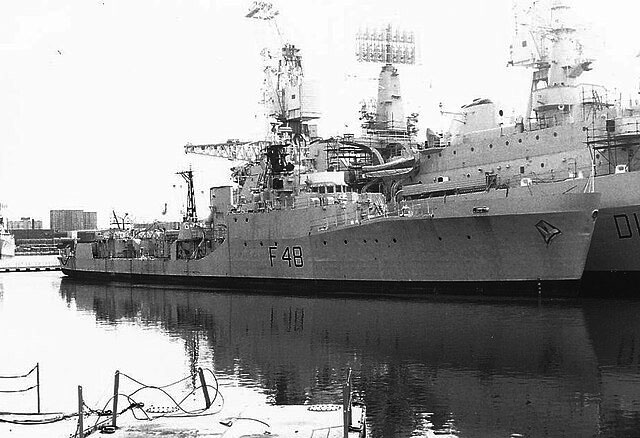
Dundas was ordered and built at JS White and Co Ltd, Cowes on 17 October 1952, launched on 25 September 1953 and completed in March 1956, commissined on 16 March 1956 for £1,434,000. She appeared in the Ava Gardner film “The Little Hut” in 1957 and also in a brief footage in 1964 “Look at Life” episode “The Price of Valour”. In 1966 she was in the 2nd Frigate Squadron based at Portland for ASW training and at Portsmouth Navy Days. She had a 14-month refit at Gibraltar until 21 June 1968 and was at Navy Days Portsmouth and well as for 1970 and still in ASW training at Portland. She took part in the 1977 Silver Jubilee Fleet Review off Spithead. Due to an unrepairable propeller shaft knoc when off Portsmouth ans examination in dry dock she was towed to Chatham and the crew transferred to HMS Hardy. She was scrapped in Troon in April 1983.
 HMS Murray (F91)
HMS Murray (F91)
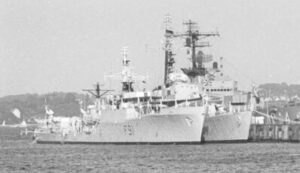
HMS Murray was laid down at Alexander Stephen and Sons Ltd of Glasgow on 30 November 1953, launched on 22 February 1955 and completed on 5 June 1956, commissioned the ame day at a cost of £1,625,000. She was featured with other Type 14 frigates in the 1960 Norman Wisdom film “The Bulldog Breed”. She worked for the coastal command in submarine hunting and was in a coastal command training film of the 1950s. She was Broken up in 1970.
 HMS Keppel (F85)
HMS Keppel (F85)
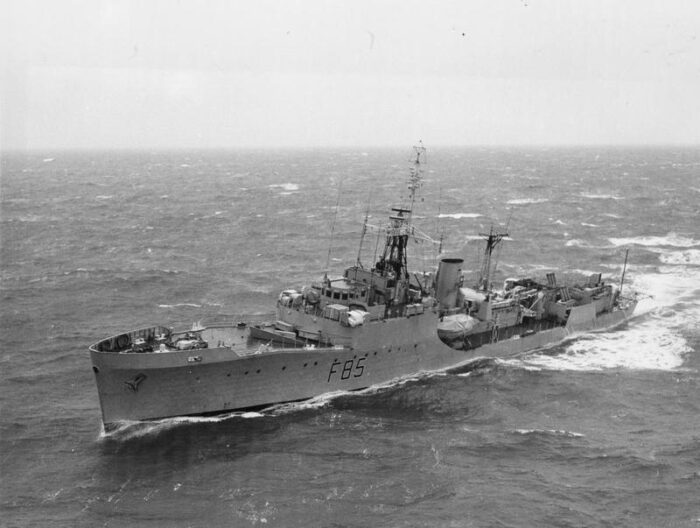
Keppel was laid down at Yarrow and Co. Ltd. of Scotstoun, Glasgow on 27 March 1953, launched on 31 August 1954 and completed and commissioned the same day on 6 July 1956 at a cost of £1,506,000. She joined the 2nd Training Squadron at Portland Harbour and was paid off for an extended refit in March 1958. Her hull was strengthened due to operating experience in heavy seas. In September 1960 she was back to the Portland Training Squadron. From June 1963 to April 1964 she was sent to reinforce the Fishery Protection Squadron to Iceland. In February 1973 she was reduced to reserve but joined the Standby Squadron at Chatham. She was listed for disposal after a boiler explosion on Hardy, and acted as stationary TS for the 2nd Frigate Squadron at Portland and was in active service to replace Hardy from July 1975 as the latter was not repaired. She only left the 2nd Frigate Squadron as TS by November 1976. Sold in 1977 she was scrapped at Sittingbourne in 1979.
 HMS Pellew (F62)
HMS Pellew (F62)
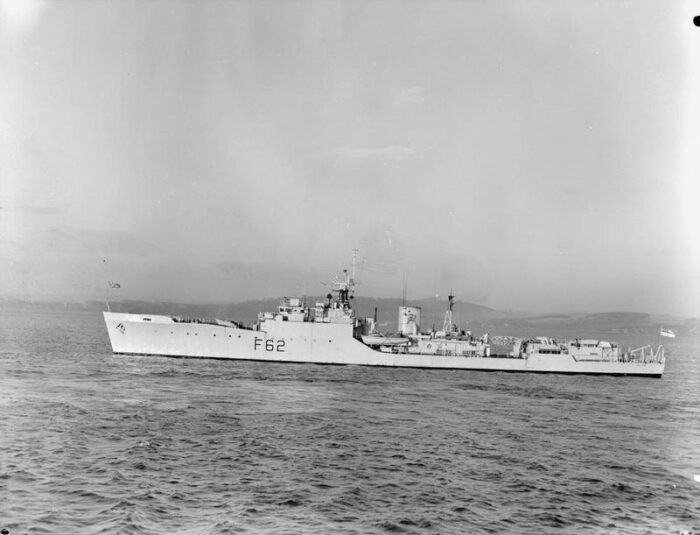
Pellew was laid down at Swan, Hunter & Wigham Richardson Ltd. on Wallsend-on-Tyne, laid down at the Wallsend Slipway & Engineering Co Ltd, on 5 November 1953 and launched on 29 September 1954, then completed on 26 July 1956 and commissioned the same day for £1,548,000. She was named after Captain Sir Edward Pellew, later Viscount Exmouth. In 1965, she was part of the 2nd Frigate Squadron at Portland. Her peacetime role was to train officers and ratings in anti-submarine warfare. Between 1964 and 1965 she visited both Calais, and Kiel as well as Flushing, Cherbourg and Jersey. She also took part in Portsmouth Navy Days in 1965 and was adopted by the town of Teignmouth. She was sold for BU, to Fleetwood, Lancashire in 1971.
 HMS Grafton (F51)
HMS Grafton (F51)
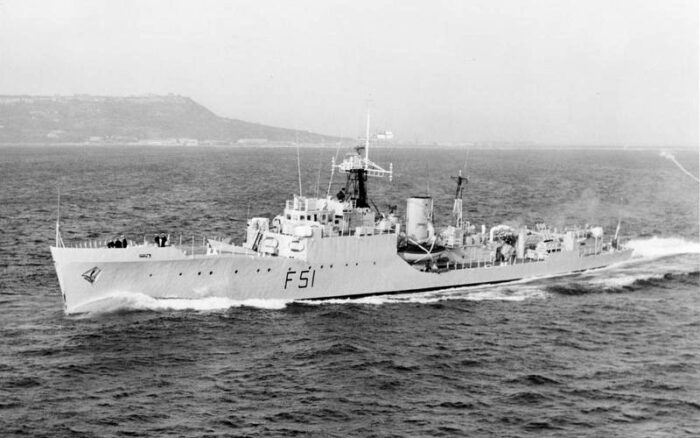
Grafton was laid down at JS White and Co Ltd, Cowes in the Isle of Wight on 25 February 1953, launched on 13 February 1954 and completed/commissioned on 8 January 1957 at a cost of £1,411,000.
She was assigned to the 2nd Frigate Squadron based at Portland until March 1963, and then started a refit at Portsmouth. After her refit, she joined the 20th Frigate Squadron based at Londonderry in Northern Ireland and was based there until April 1969, then paid off. She took part in Portsmouth Navy Days in 1967 and 1968. Placed in reserve she was ultimately sold for BU at Inverkeithing from December 1971.
 HMS Russell (F97)
HMS Russell (F97)
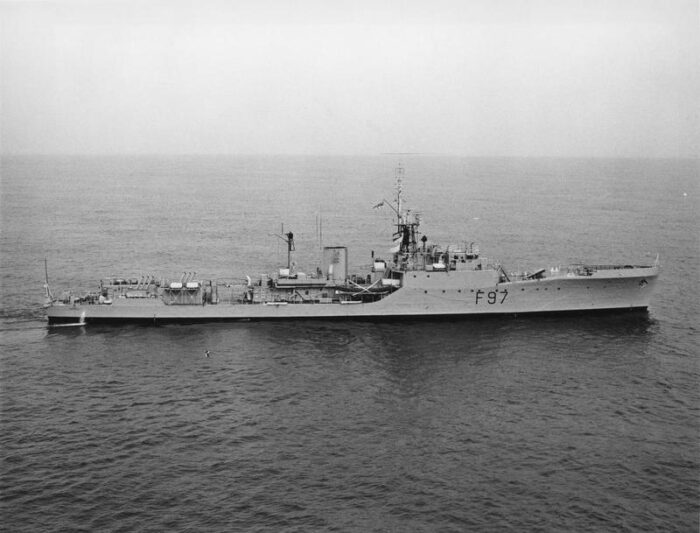
Russel (after Thomas McNamara Russell, admiral in a career spanning the American Revolutionary War, French Revolutionary War and the Napoleonic Wars.) was laid down at Swan, Hunter & Wigham Richardson Ltd, Wallsend-on-Tyne on 11 November 1953, launched on 10 December 1954 and completed on 7 February 1957, commissioned the same day at a cost of £1,581,000. She joined the Second Training Squadron at Portland. In January 1958 she was sent to the Fishery Protection Squadron until April 1963 taking part in the “Cod Wars”. On 4 September 1960, ICGV Ægir, an Icelandic patrol vessel, attempted to forcibly tow and intern a British fishing trawler off the Westfjords, thwarted as Russell intervened, and the two ships collided.
On 12 November 1960, Þór try to board the trawler Hackness fishing in international waters, after firing two blanks and one live shell off her bow. Russell came to assist the trawler and threated the Icelandic captain to leave the trawler alone as being in the 4 nmi (7.4 km) limit recognised by the British government. Þór’s captain, Eiríkur Kristófersson instead ordered his men to approach the trawler with the gun manned and Russell threatened to sink the Icelandic ship with hos own Squid mortars, now she was close enough for this. The situation deflated after more British ships came in and Hackness retreated beneath them. After a refit at Rosyth, she joined the 20th Frigate Squadron at Londonderry and was used for ASW training. In 1966, she was present at Portsmouth Navy Days. She was broken up 1985.
 HMS Blackwood (F78)
HMS Blackwood (F78)

Blackwood, the class leader, was laid down at JI Thornycroft and Co Ltd, Woolston, Southampton on 14 September 1953, launched on 4 October 1955 and commissioned on 22 August 1957 at a cost of £1,769,000. No logs. She was broken up in 1976.
 HMS Malcolm (F88)
HMS Malcolm (F88)
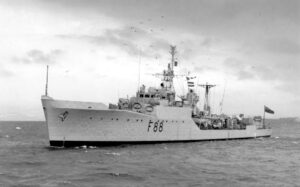 Malcolm was laid down at Yarrow and Co Ltd, Scotstoun, Glasgow on 1 February 1954, launched on 18 October 1955 but completed at Parsons Marine Steam Turbine Co, Wallsend-on-Tyne on December 1957 and commissioned the same day for £1,582,000. She was named after Pulteney Malcolm (1768-1838). She was immediately sent to take part in the standoff against Iceland after the dclaration of new territorial waters limited, enforced by the Landhelgisgæsla (the Icelandic Coast Guard) which started to threat British fishermen fishing in what they considered international waters. This became the “cold wars”; an ongoing fisehery dispute that lasted for decades. Malcolm entered the Fishery Patrol Squadron in April 1959 and until 1965, part of a five-ship group deployed off Iceland, out of Edinburgh and later from Rosyth. She was refitted at Rosyth from February 1965 and until March 1966, and then joined Fishery Patrol Squadron. In 1967 she was with the 20th Frigate Squadron based at Londonderry, training with submarines but returned for fishery protection patrols. By December 1970, Kevin McNamara MP decided not to replace Malcolm immediately until the calmed between the first and second Cod Wars. This affait was moved to the Department of Trade and Industry and ended in 1976. Malcolm was decommissioned in 1978 and scrapped soon after being sold.
Malcolm was laid down at Yarrow and Co Ltd, Scotstoun, Glasgow on 1 February 1954, launched on 18 October 1955 but completed at Parsons Marine Steam Turbine Co, Wallsend-on-Tyne on December 1957 and commissioned the same day for £1,582,000. She was named after Pulteney Malcolm (1768-1838). She was immediately sent to take part in the standoff against Iceland after the dclaration of new territorial waters limited, enforced by the Landhelgisgæsla (the Icelandic Coast Guard) which started to threat British fishermen fishing in what they considered international waters. This became the “cold wars”; an ongoing fisehery dispute that lasted for decades. Malcolm entered the Fishery Patrol Squadron in April 1959 and until 1965, part of a five-ship group deployed off Iceland, out of Edinburgh and later from Rosyth. She was refitted at Rosyth from February 1965 and until March 1966, and then joined Fishery Patrol Squadron. In 1967 she was with the 20th Frigate Squadron based at Londonderry, training with submarines but returned for fishery protection patrols. By December 1970, Kevin McNamara MP decided not to replace Malcolm immediately until the calmed between the first and second Cod Wars. This affait was moved to the Department of Trade and Industry and ended in 1976. Malcolm was decommissioned in 1978 and scrapped soon after being sold.
 HMS Palliser (F94)
HMS Palliser (F94)
 Palliser was laid down at Alexander Stephen and Sons Ltd of Glasgow on 15 March 1955, launched on 10 May 1956 and completed and commissioned on 13 December 1957 for £1,620,000. She joined the Fishery Protection Squadron until April 1967 and took part in the first Cod Wars. By 10 July 1960 when the Icelandic gunboat Óðinn fired on the British trawler Grimsby Town, as claiming she was into Icelandic 12 mile territorial waters, her funnel was hit and the trawler asked for help. Palliser came up and prevented Óðinn from boarding the trawler. On 22 January 1971 entered the 2nd Frigate Squadron, Portland Harbour. In May 1973 she was paid off and laid up for disposal. By 1983 she was sold for scrapd at S Dean and Sons at Briton Ferry but attempts to tow her there were marred by fog, and 9 February 1983 when towed by the tug Alnwick, she collided with her, forcing both back to Plymouth for repairs. Fog at Swansea Bay, forcing them to miss the correct tide and at Neath on 27 March, Palliser ran aground.
Palliser was laid down at Alexander Stephen and Sons Ltd of Glasgow on 15 March 1955, launched on 10 May 1956 and completed and commissioned on 13 December 1957 for £1,620,000. She joined the Fishery Protection Squadron until April 1967 and took part in the first Cod Wars. By 10 July 1960 when the Icelandic gunboat Óðinn fired on the British trawler Grimsby Town, as claiming she was into Icelandic 12 mile territorial waters, her funnel was hit and the trawler asked for help. Palliser came up and prevented Óðinn from boarding the trawler. On 22 January 1971 entered the 2nd Frigate Squadron, Portland Harbour. In May 1973 she was paid off and laid up for disposal. By 1983 she was sold for scrapd at S Dean and Sons at Briton Ferry but attempts to tow her there were marred by fog, and 9 February 1983 when towed by the tug Alnwick, she collided with her, forcing both back to Plymouth for repairs. Fog at Swansea Bay, forcing them to miss the correct tide and at Neath on 27 March, Palliser ran aground.
 HMS Exmouth (F84)
HMS Exmouth (F84)
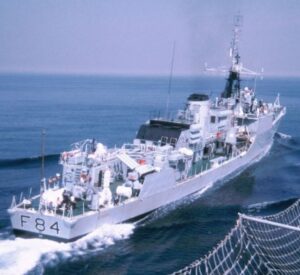 Exmouth was laid down at JS White and Co Ltd, Cowes, Isle of Wight on 24 March 1954, launched on 16 November 1955 and completed and commissioned on 20 December 1957 for £1,422,000.
Exmouth was laid down at JS White and Co Ltd, Cowes, Isle of Wight on 24 March 1954, launched on 16 November 1955 and completed and commissioned on 20 December 1957 for £1,422,000.
After an uneventful career until 1965 she was converted as a Gas Turbine prototype and after many modifications, rejoined the fleet on 5 June 1968. In the 1970s she carried out extended trials to validate an all-gas turbine propulsion system. Only after 64 hours however an entire ring of Olympus turbine blades failed. After repairs she was tested in the Mediterranean in summer, notably from Malta, Crete and as plane guard for Ark Royal looked for survivors after a Russian destroyer lost 3 men overboard when making a hazardous pass ahead of Ark Royal at full speed. She was back in Chatham and tested he rpowerplant off the Isle of Portland as a day runner with the 2nd Frigate Squadron, used stop/start scenario and the trials were ultimately successful. The Olympus were adopted for the Type 42 destroyer and Type 21, Type 22 frigates whle also being a tremendous export success. Exmouth was BU in 1979.
 HMS Duncan (F80)
HMS Duncan (F80)
 HMS Duncan (F80) was laid down at JI Thornycroft and Co Ltd, Woolston, Southampton on 17 December 1953, launched on 30 May 1957 and completed on 21 October 1958 at a cost of £1,960,000. From 1958 to 1965 she became leader of the Fishery Protection Squadron in the First Cod War. She escorted the royal yacht Britannia in August 1960. In 1960-1962 her captain was George Cunningham Leslie and until 1964 Richard Trowbridge, laterRear Admiral and Flag Officer on Royal Yachts, later Governor of Western Australia 1980-1983. In 1964 saluted the opening of the new Forth Road Bridge. In 1966 she had a long modernisation for all her sonar and ASW gear at Rosyth and sent for anti-submarine training at Londonderry Squadron and from 1969 Portland Training Squadron and attending Portsmouth Navy Days in 1967 and 1970 while being assigned to the Portland Training Squadron. On 2 April 1971 she paid off and in the early 1980s, served alongside the frigate HMS Eastbourne as harbour training ship at Rosyth for the marine engineering artificer apprentices, HMS Caledonia. She was eventually BU in 1985.
HMS Duncan (F80) was laid down at JI Thornycroft and Co Ltd, Woolston, Southampton on 17 December 1953, launched on 30 May 1957 and completed on 21 October 1958 at a cost of £1,960,000. From 1958 to 1965 she became leader of the Fishery Protection Squadron in the First Cod War. She escorted the royal yacht Britannia in August 1960. In 1960-1962 her captain was George Cunningham Leslie and until 1964 Richard Trowbridge, laterRear Admiral and Flag Officer on Royal Yachts, later Governor of Western Australia 1980-1983. In 1964 saluted the opening of the new Forth Road Bridge. In 1966 she had a long modernisation for all her sonar and ASW gear at Rosyth and sent for anti-submarine training at Londonderry Squadron and from 1969 Portland Training Squadron and attending Portsmouth Navy Days in 1967 and 1970 while being assigned to the Portland Training Squadron. On 2 April 1971 she paid off and in the early 1980s, served alongside the frigate HMS Eastbourne as harbour training ship at Rosyth for the marine engineering artificer apprentices, HMS Caledonia. She was eventually BU in 1985.
The Indian Khurki class
 F149 Khukri
F149 Khukri
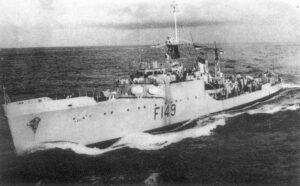 She was built at JS White and Co Ltd, Cowes, Isle of Wight, laid down on 29 December 1955, launched on 20 November 1956 and completed on 16 July 1958. She took part already in the war of 1965 patrolling. After the start of the 1971 war between Indian and Pakistan on 3 December, and Indian Naval radio detection identified a submarine 35 miles (56 km) SW of Diu harbour. The 14th Frigate Squadron in which she was, Western Fleet, was dispatched to find and detroy the submarine with her sisters Kirpan, Kuthar, but also Kalveti, Krishna. The sub was a modern Daphne-class submarine. She conversely sighted the squadron on 9 December, and Khukri did not detected her as she was testing a locally improved version of the 170/174 sonar at low speed, even if it was against the RIN doctrine. At 19:57 PNS Hangor fired a homing torpedo at Kirpan, missed (dud), but she was detected. Kirpan turned away and fireed her ASW mortars but missed. Khukri then sped up to the dub last possible poistion, when the latter fired a second torpedo “down the throat” at Khukri, which struck her, exploding under her oil tanks. According to commander Commander Ahmed Tasnim, she sank in two minutes. Kirpan attacked Hangor but missed and the later fired a final torpedo at Kirpan, dodged, before leaving the area. Khurkri so became the onlt Frigate of her class sunk in action.
She was built at JS White and Co Ltd, Cowes, Isle of Wight, laid down on 29 December 1955, launched on 20 November 1956 and completed on 16 July 1958. She took part already in the war of 1965 patrolling. After the start of the 1971 war between Indian and Pakistan on 3 December, and Indian Naval radio detection identified a submarine 35 miles (56 km) SW of Diu harbour. The 14th Frigate Squadron in which she was, Western Fleet, was dispatched to find and detroy the submarine with her sisters Kirpan, Kuthar, but also Kalveti, Krishna. The sub was a modern Daphne-class submarine. She conversely sighted the squadron on 9 December, and Khukri did not detected her as she was testing a locally improved version of the 170/174 sonar at low speed, even if it was against the RIN doctrine. At 19:57 PNS Hangor fired a homing torpedo at Kirpan, missed (dud), but she was detected. Kirpan turned away and fireed her ASW mortars but missed. Khukri then sped up to the dub last possible poistion, when the latter fired a second torpedo “down the throat” at Khukri, which struck her, exploding under her oil tanks. According to commander Commander Ahmed Tasnim, she sank in two minutes. Kirpan attacked Hangor but missed and the later fired a final torpedo at Kirpan, dodged, before leaving the area. Khurkri so became the onlt Frigate of her class sunk in action.
 F144 Kirpan
F144 Kirpan
Kirpan was laid down at Alexander Stephen and Sons Ltd of Glasgow on 5 November 1956, launched on 19 August 1958 and completed on July 1959. She was transferred to Coast Guard Service 1978 and Decommissioned in 1987.
 F146 Kuthar
F146 Kuthar
Kuthar was ordered and laid down to JS White and Co Ltd like Khukri, but two years later on 19 September 1957. She was launched on 14 October 1958 and completed, commissioned on November 1959. She was transferred to Coast Guard Service in 1978 like her sister and decommissioned last, in September 1988. By the time she was the last Blackwood class in service anywhere.
Read More/Src
Books
Conway’s all the world’s fighting ships 1947-95.
Colledge, J. J.; Wardlow, Ben & Bush, Steve (2020). Ships of the Royal Navy. Barnsley, UK: Seaforth Publishing.
Royal Navy Frigates 1945-1983″ Leo Marriott, Ian Allan, 1983.
Moore, George, “The dawn of the Salisbury, Leopard and Whitby class frigates” in Warship, 2004, Conways, 2004
Purvis, M.K., “Post War RN Frigate and Guided Missile Destroyer Design 1944–1969”, Transactions of the Royal Institution of Naval Architects 1974
Marriott, Leo, Royal Navy Frigates Since 1945, Second Edition, Ian Allan, Surrey, 1990
Colledge, J. J.; Warlow, Ben (2006) [1969]. Ships of the Royal Navy, Complete Record, Chatham Publishing.
Capt. John E. Moore, Warships of the Royal Navy; New Edition, Jane’s Publishing, 1981.
D. K. Brown & George Moore, Rebuilding the Royal Navy. Warship design since 1945, Chatham Publishing, 2003
Links
on hazegray.org/
on navypedia.org/
on en.wikipedia.org
on britainsnavy.co.uk
on worldnavalships.com
Model Kits
MTM037 HMS Blackwood Type 14 Frigate MT Miniatures
1:700 MTM037 HMS Exmouth Decapod Models 1:1250


 Latest Facebook Entry -
Latest Facebook Entry -  X(Tweeter) Naval Encyclopedia's deck archive
X(Tweeter) Naval Encyclopedia's deck archive Instagram (@navalencyc)
Instagram (@navalencyc)


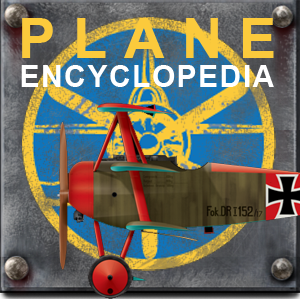
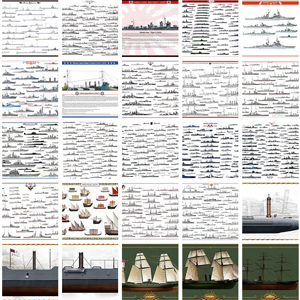

 French Navy
French Navy Royal Navy
Royal Navy Russian Navy
Russian Navy Armada Espanola
Armada Espanola Austrian Navy
Austrian Navy K.u.K. Kriegsmarine
K.u.K. Kriegsmarine Dansk Marine
Dansk Marine Nautiko Hellenon
Nautiko Hellenon Koninklije Marine 1870
Koninklije Marine 1870 Marinha do Brasil
Marinha do Brasil Osmanlı Donanması
Osmanlı Donanması Marina Do Peru
Marina Do Peru Marinha do Portugal
Marinha do Portugal Regia Marina 1870
Regia Marina 1870 Nihhon Kaigun 1870
Nihhon Kaigun 1870 Preußische Marine 1870
Preußische Marine 1870 Russkiy Flot 1870
Russkiy Flot 1870 Svenska marinen
Svenska marinen Søværnet
Søværnet Union Navy
Union Navy Confederate Navy
Confederate Navy Armada de Argentina
Armada de Argentina Imperial Chinese Navy
Imperial Chinese Navy Marinha do Portugal
Marinha do Portugal Mexico
Mexico Kaiserliche Marine
Kaiserliche Marine 1898 US Navy
1898 US Navy Sovietskiy Flot
Sovietskiy Flot Royal Canadian Navy
Royal Canadian Navy Royal Australian Navy
Royal Australian Navy RNZN Fleet
RNZN Fleet Chinese Navy 1937
Chinese Navy 1937 Kriegsmarine
Kriegsmarine Chilean Navy
Chilean Navy Danish Navy
Danish Navy Finnish Navy
Finnish Navy Hellenic Navy
Hellenic Navy Polish Navy
Polish Navy Romanian Navy
Romanian Navy Turkish Navy
Turkish Navy Royal Yugoslav Navy
Royal Yugoslav Navy Royal Thai Navy
Royal Thai Navy Minor Navies
Minor Navies Albania
Albania Austria
Austria Belgium
Belgium Columbia
Columbia Costa Rica
Costa Rica Cuba
Cuba Czechoslovakia
Czechoslovakia Dominican Republic
Dominican Republic Haiti
Haiti Hungary
Hungary Honduras
Honduras Estonia
Estonia Iceland
Iceland Eire
Eire Equador
Equador Iran
Iran Iraq
Iraq Latvia
Latvia Liberia
Liberia Lithuania
Lithuania Mandchukuo
Mandchukuo Morocco
Morocco Nicaragua
Nicaragua Persia
Persia San Salvador
San Salvador Sarawak
Sarawak Uruguay
Uruguay Venezuela
Venezuela Zanzibar
Zanzibar Warsaw Pact Navies
Warsaw Pact Navies Bulgaria
Bulgaria Hungary
Hungary

 Bundesmarine
Bundesmarine Dutch Navy
Dutch Navy Hellenic Navy
Hellenic Navy Marina Militare
Marina Militare Yugoslav Navy
Yugoslav Navy Chinese Navy
Chinese Navy Indian Navy
Indian Navy Indonesian Navy
Indonesian Navy JMSDF
JMSDF North Korean Navy
North Korean Navy Pakistani Navy
Pakistani Navy Philippines Navy
Philippines Navy ROKN
ROKN Rep. of Singapore Navy
Rep. of Singapore Navy Taiwanese Navy
Taiwanese Navy IDF Navy
IDF Navy Saudi Navy
Saudi Navy Royal New Zealand Navy
Royal New Zealand Navy Egyptian Navy
Egyptian Navy South African Navy
South African Navy






























 Ukrainian Navy
Ukrainian Navy dbodesign
dbodesign